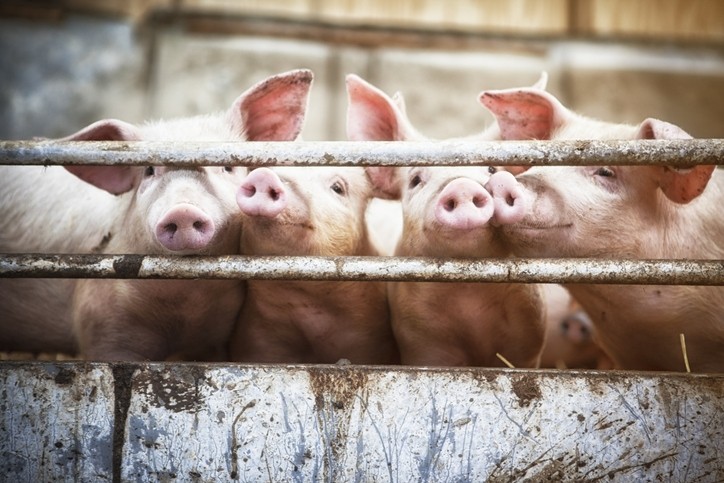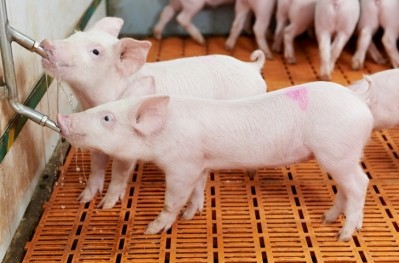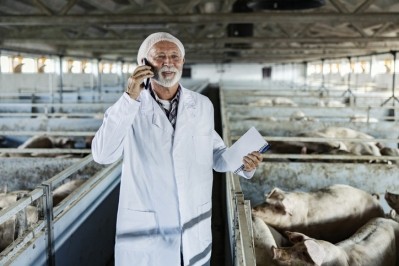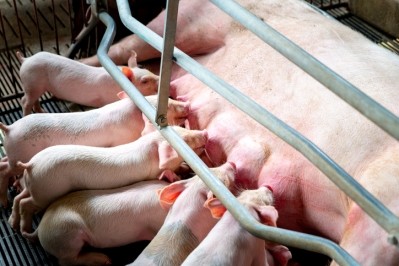Weaning age plays a key role in feed intake by piglets

However, the researchers, writing in Livestock Science, said the effect on gut health and on diarrhea incidence needs to be investigated to evaluate whether delayed weaning is an effective alternative to antibiotics and medical zinc.
The authors wanted to investigate the impact of weaning age and/or supplemental liquid feed in the farrowing pen on pre- and post-weaning feed intake.
Weaning challenges
Piglets, they outlined, are subjected to an abrupt feed change at weaning from milk to solid feed. This frequently results in a reduced feed intake, reduced growth and diarrhea. To treat diarrhea, antibiotics or medical zinc is widely used.
High use of antibiotics is, in turn, associated with high risk of developing antimicrobial resistance (Gresse et al., 2017), and since the use of medical zinc will be banned in the EU from 2022 (Directive 2001/82/EC 2017), the hunt is on for alternatives to prevent or reduce post-weaning diarrhea (PWD), said the researchers.
The common weaning practice is to remove piglets from the sow between 18 and 35 days of age, depending on the country (Edwards et al., 2020), they commented.
Within the EU, the minimum age is 28 days while 21 days is allowed in cases where piglets are weaned in batches into cleaned and sectioned pens.
The researchers noted that with increasing litter size, the weaning age tends to be driven towards the lower age due to the use of nurse sows and space limitations in the farrowing unit (Baxter et al., 2020). “For example, the mean weaning age in Denmark is reported to be 25 days of age in average (Udesen and Christiansen, 2017).”
Another challenge is that, due to variation in farrowing day and to the oldest born litters determining the weaning time for the entire batch, the youngest litters may be several days younger.
Potential strategies
The immunological state of piglets at this age is characterized by a gap in the protective immune system due to lack of maternal immunity and an immature immune system. Piglets’ active immunity is developed from about 4-5 weeks of age (McCracken and Kelly, 1993), and thus weaning after this point is assumed to increase piglets’ resilience to diarrhea, reported the authors.
“Weaning at a later age will also give piglets more time to start eating as well as increase body weight and gut maturity and thus start adapting their gastrointestinal tract to plant-based solid feed gradually (Dong and Pluske, 2007).
“Previous studies have shown that later weaning increases feed intake post-weaning (Davis et al., 2006; van der Meulen et al., 2010). As such, increasing weaning age is a potential strategy to mitigate the abrupt feed change at weaning.”
The abrupt feed change may also be mitigated if the piglets start eating pre-weaning, they argue.
“Previous results have shown that eaters of solid feed pre-weaning start eating earlier post-weaning than non-eaters (Bruininx et al., 2002).
“However, getting piglets to eat solid feed before week 4 after birth has largely been unsuccessful, and only in average around 50% of piglets within a litter eat pre-weaning (Bruininx et al., 2002; Heo et al., 2018),” they noted.
An alternative to providing solid feed pre-weaning is to provide milk replacer/liquid feed, said the team.
“There is increasing interest in providing sow-reared piglets with milk replacer, mainly due to the large litter size of modern hyper-prolific sows, which due to greater resemblance to sow milk may hold more interest for piglets than solid feed.”
And the researchers said that, in many farms using commercial milk replacer systems, it is standard to change the supplemental milk replacer to a cereal-based feed resembling liquid feed at around day 12.
“By continuing the same supplemental feed into the first week post-weaning (in liquid or dry form), the feed change will become less abrupt and help initiate and promote the gut and digestive enzyme development that may help piglets to utilize other feed sources once milk is removed (De Passillé et al., 1989).”
However, as seen with solid feed pre-weaning, the authors said that piglets may have minimal motivation to consume milk replacer when they can suckle the sow (Kobek-Kjeldager et al., 2020a).
Objective
Therefore, they said the aim of their study was to investigate piglet eating behavior of automatically provided supplemental milk/feed in the farrowing pen when it transitioned from milk replacer to liquid feed and to study how eating pre-weaning and weaning age affected the latency and bouts of eating and drinking water post-weaning.
Methodology
The study consisted of 24 sows and their litters in a 2 × 2 factorial design.
The design factors were weaning age (Weaning Age) at either 24 days (D24) or 35 days (D35) and with or without access to supplementary liquid milk replacer/feed (+Sup Feed/-Sup Feed).
Individual eating behavior pre- and post-weaning was observed on video recordings.
Findings
The results showed that the majority of piglets ingested liquid supplemental feed pre-weaning, but the ingestion bouts decreased at the transition from milk-based to cereal-based supplemental feed on day 12 of lactation.
On days 23 and 34 (the day before weaning), piglets with lower suckling success had more bouts of ingesting supplemental feed, said the animal scientists.
The study showed that later weaning, rather than supplemental feed pre-weaning, increased feed intake post-weaning.
However, independent of treatments, piglets experienced a fasting period post-weaning, confirmed the research team.








